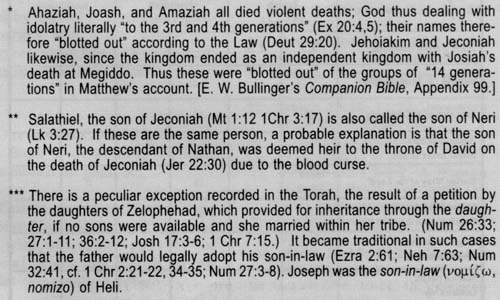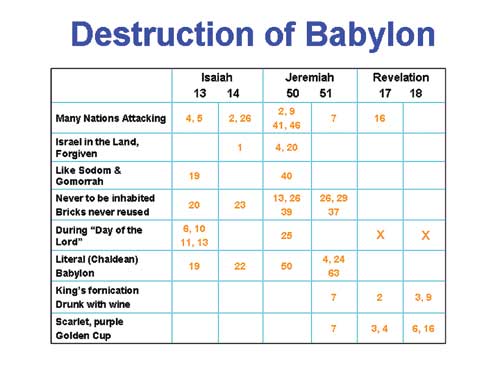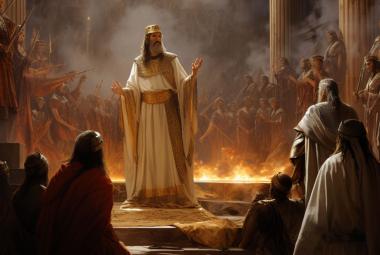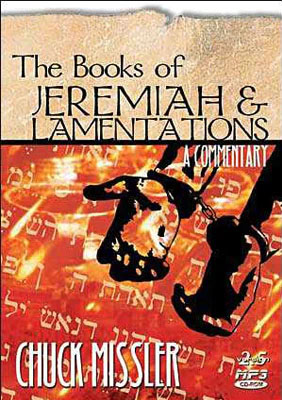Here is one of the bravest and most tender, yet most pathetic figures in all history: a patriot as well as a prophet.
Jeremiah ministered for over 40 years, about 80 years after Isaiah and during the reigns of the last four kings of the Southern Kingdom.
He is known as the Weeping Prophet: he watched his nation decline and finally fall under God's judgment.
Oh, that my head were waters, and mine eyes a fountain of tears, that I might weep day and night for the slain of the daughter of my people!
Jeremiah 9:1
[Isn't there a parallel to our own national predicament?]
Jeremiah and Ezekiel railed against the false prophets. Ezekiel, a priest/prophet like Jeremiah, was one of ten thousand captives taken in the second siege of Nebuchadnezzar, 11 years before the final overthrow of Jerusalem.
During Jeremiah's 40 years of ministry, he never received a hint of gratitude; in fact, he was imprisoned as a traitor because of the unpopularity of his message.
The Babylonian Captivity
Among his many prophecies, Jeremiah predicted that the duration of the Babylonian captivity would be precisely 70 years.1
(In fact, it was when the captive Daniel was reading Jeremiah's prophetic writings2 that he undertook serious prayer, which was then interrupted by the Angel Gabriel who gave him the famed Seventy Week Prophecy. Jesus later highlighted this very passage as the key to end-time prophecy.3)
The reason the judgment of the captivity was to be exactly 70 years is highlighted in 2 Chronicles:
And them that had escaped from the sword carried he away to Babylon; where they were servants to him and his sons until the reign of the kingdom of Persia:
To fulfil the word of the LORD by the mouth of Jeremiah, until the land had enjoyed her sabbaths: for as long as she lay desolate she kept sabbath, to fulfil threescore and ten years.
2 Chronicles 36:20-21
Apparently, for 490 years they had failed to keep the sabbath of the land; the Lord was saying, in effect, "You owe me 70!" (See the article Sabbath Crisis in Israel.)
The "servitude of the nation" began with the first siege of Nebuchadnezzar in 606 B.C. and ended with the release of the Jewish captives when Cyrus the Great conquered Babylon in 539 B.C.4
This 70-year period is not to be confused with a similar 70-year period, called "the desolations of Jerusalem," which began with the third siege of Nebuchadnezzar. Each was fulfilled to the very day.
It is instructive to note the remarkable precision of the Scriptures: The city of Jerusalem was invaded on the tenth day of the tenth month, Tebeth, in the ninth year of Zedekiah in 589 B.C. 5 (And for 25 centuries this day has been observed as a fast by Jews in every land.)
Scripture clearly indicates that this era closed on "the four and twentieth day of the ninth month, [Kislev] even from the day that the foundation of the LORD'S temple was laid,"6 which was in 520 B.C. This is an interval of precisely 25,200 days, or seventy 360-day years.7
(For an exploration of how these dates may be applied to the mysterious 430 years prophesied in Ezekiel 4, see the article Ezekiel's 430 days.)
The Curse on Jeconiah
The kings of the southern kingdom had gone from bad to worse, and one of the most provocative paradoxes in Scripture emerges from the blood curse that God pronounced on Jeconiah:
Thus saith the LORD, Write ye this man childless, a man that shall not prosper in his days: for no man of his seed shall prosper, sitting upon the throne of David, and ruling any more in Judah.
Jeremiah 22:30
What makes this so remarkable is that the Messiah was prophesied to come from the royal line of David.8Now there was a blood curse on that very royal line!
(I always imagine that there must have been a celebration in the counsels of Satan then, since they must have assumed that they now had God in an unsolvable corner: how can the Messiah come from the royal line that is now subject to a blood curse? But then I visualize God turning to the angels and saying, "Watch this one!")
Two Genealogies of Jesus
When we get to the New Testament, we discover two genealogies of Jesus Christ. Matthew, as a Jew and focusing on Jesus as the Messiah, begins his with Abraham and follows the royal line through David, and the first surviving son of Bathsheba, Solomon, on to Joseph, the legal father of Jesus Christ.
Luke, however, as a doctor focuses on Jesus as the Son of Man, and takes his genealogy from Adam - the first man - and then from Abraham to David, they are identical.
However, when Luke gets to David, rather than go through Solomon, he follows the line from Nathan, the second surviving son of Bathsheba, and takes his genealogy to Mary, identifying Joseph as the son-in-law of Heli, Mary's father.9
[See the chart The Genealogy of Jesus Christ]

The virgin birth, prophesied in Isaiah (as well as the hint in Genesis 3)10 is thus an "end run" on the blood curse on the descendants of Jeconiah.
(This should provide some offbeat conversational material as we approach the Christmas holidays! And isn't it fascinating to discover some of the hidden treasures tucked away in the nooks and crannies of Scripture!)
The Doom of Babylon
Another of the key prophecies in Jeremiah has to do with the destruction of Babylon.
It is important to distinguish between the destruction of Babylon prophesied here and the fall of Babylon to the Persians in 539 B.C.
When Cyrus conquered Babylon, it was without a battle: it wasn't destroyed. (Many Biblical helps are in error here.) It became Cyrus' secondary capital.
Two centuries later, when Alexander conquered the Persians, he made it his capital. He died there. It gradually atrophied over the centuries, displaced by alternative caravan routes, etc. As late as the 19th century, when Koldewey, the archaeologist, excavated the ruins, he was able to hire locals still living there.
The destruction of Babylon prophesied by Jeremiah has never happened (yet). Both Jeremiah and Isaiah describe a destruction after which it is "never to be inhabited"; the building materials will never be reused, etc. 11 It is to be destroyed like Sodom and Gomorrah.12 This has never happened. So far.
If we are to take the Bible seriously, Babylon has yet to experience this final judgment to these very specifications.
This is what makes the rebuilding of Babylon (which has begun under Saddam Hussein of Iraq) so potentially significant from a Biblical standpoint.
"Mystery Babylon?"
There are, of course, many scholars who believe the Babylon referred to in Revelation13 is a symbolic allusion to the Vatican.14 What then is the relationship between the prophecies in Jeremiah and Isaiah (which clearly depict Babylon on the Euphrates as their subject15 ) in contrast to the more mystical allusions in the Book of Revelation? Both are also clearly at the end-time, during the "Day of the Lord."16
(It is very useful to read Isaiah 13 and 14, Jeremiah 50 and 51, and Revelation 17 and 18 at one sitting to fully appreciate how closely these six chapters are related to each other.)

The Null Hypothesis
The possible linkage between these two ostensibly contradictory views may be reconciled by the vision in Zechariah 5:5-11, which suggests that the power center that migrated from Babylon to Rome is destined to return to its original base to receive its final judgment. This implies that present Babylon, a relatively modest group of restored buildings by Saddam Hussein, will emerge once again as a major power center. This can only be resolved by simply watching what happens next.
The Vatican has manifested its strategy to assume the leadership of a worldwide ecumenical movement, and it is also taking an active part in the intrigues involving Jerusalem and the Temple Mount. But will it also, somewhere along the way, involve itself with the traditional site of the ancient city of Babylon? The more farfetched it seems at the moment, the more impressive it will be if it happens! Stay tuned.
The New Covenant
One of the most important passages in Jeremiah is God's announcement of a New Covenant:
Behold, the days come, saith the LORD, that I will make a new covenant with the house of Israel, and with the house of Judah:
Not according to the covenant that I made with their fathers in the day that I took them by the hand to bring them out of the land of Egypt; which my covenant they brake, although I was an husband unto them, saith the LORD:
But this shall be the covenant that I will make with the house of Israel; After those days, saith the LORD, I will put my law in their inward parts, and write it in their hearts; and will be their God, and they shall be my people.
And they shall teach no more every man his neighbour, and every man his brother, saying, Know the LORD: for they shall all know me, from the least of them unto the greatest of them, saith the LORD: for I will forgive their iniquity, and I will remember their sin no more.
Jeremiah 31:31-34
Both the Epistle to the Romans and the Epistle to the Hebrews elaborate on the implications of this profound change in the covenant relationship with God. In fact, it is from this passage in Jeremiah that the New "Testament" gets its name!
A Challenge
As one of the most important of the "Major Prophets," Jeremiah is a rich, rewarding study. It is full of surprises, deeply touching episodes, and extremely moving reading. It is also, in many ways, profoundly timely for us today!
But it is also a book that is most rewarding when accompanied by a good expositional commentary and other historical helps close at hand. A grand adventure, indeed! Good hunting!
Notes:
- Jeremiah 25:11, 12; 29:10.
- Daniel 9:2.
- Matthew 24:15; Daniel 9:24-27.
- Daniel 5. Cf. Isaiah 44:28-45:3.
- Jeremiah 52:4; Ezekiel 24:1, 2; 2 Kings 25:1.
- Haggai 2:10, 15-19.
- The precise calendar difference is 25,202 days: the reckoning began the day after the Babylonian army invaded, and ended the day before the foundation of the 2nd temple was laid. For a detailed exposition, see The Coming Prince, by Sir Robert Anderson, Appendix I.
- 2 Samuel 7:12-16; Psalm 89:3, 4; 110:1; 132:11; Isaiah 9:6, 7; 11:1; et al.
- Luke 3:23, nomi,zw, nomizo, reckoned as by law. This derives from the specific exception granted in the Torah to the daughters of Zelophehad (Numbers 27:1-11; Joshua 17:3-6), and by which the son-in-law inherits (Cf. Ezra 2:61; Nehemiah 7:63; Numbers 32:41; 1 Chronicles 2:21-23, 34-35.).
- Genesis 3:15, "the seed of the woman" (a contradiction in terms), and also prophesied in Isaiah 7:14.
- Isaiah 13:20; 14:23; Jeremiah 50:13 26, 39; 51:26, 29, 37.
- Isaiah 13:19; Jeremiah 50:40.
- Revelation 17 & 18.
- Dave Hunt's book, A Woman Rides The Beast, is certainly the most contemporary and best- documented analysis supporting this view.
- Isaiah 13:19; 14:22; Jeremiah 50:50; 51:4, 24, 63.
- Isaiah 13:6, 10-11, 13; Jeremiah 50:25.







